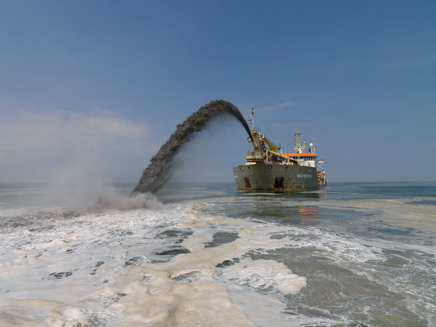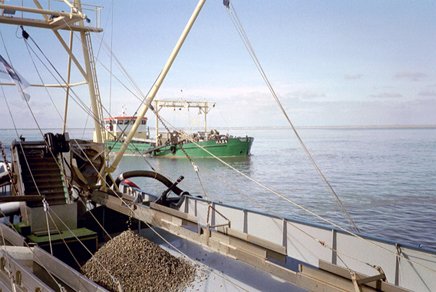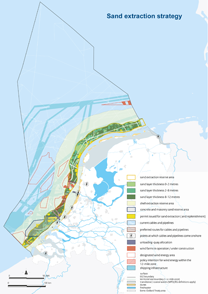Surface mineral extraction
On the North Sea, organisations with a permit can extract sand and gravel seawards from the ongoing Amsterdam Ordnance Datum (NAP) -20 metre isobath. The extraction of gravel is rare, while the extraction of sand is very common. Sand extraction is even an activity of national importance. Shells may be extracted in water deeper than -5 metres NAP.
Sand extraction area
An area has been reserved for sand extraction between the 12-mile limit and the ongoing NAP -20 m isobath. In this area, which covers 5,134 km2, sand extraction is given priority, but other user functions are also possible. Large-scale sand extraction, with extraction depths of more than 2 metres, is permitted from 2 km seawards of the ongoing NAP -20 m isobath.
Sand for coastal maintenance and fill sand

The sea sand is used to maintain the coast (currently about 12 million m3 per year) and as filling material on shore (currently about 13 million m3 per year). By applying sand to the beach and the seabed, we prevent the Dutch coastline from shifting landward. It is preferable to apply the sand under water instead of on the beach. This causes less inconvenience for holiday-makers and is usually cheaper.
Large amounts of sand are used for specific projects. For coastal maintenance, that was done for the Sand Motor in Delfland (21.5 million m³ in 2011/2012) and the Hondsbossche and Pettemer sea defences (35 million m³ in 2014). A much larger amount was extracted for the construction of Maasvlakte 2 (approx. 213 million m³ in 2009-2013).
Coastal maintenance
Given the expected rise in sea level, long-term safety also plays a key role in maintaining the coast. It is not inconceivable that the demand for sand for coastal maintenance will grow to approximately 85 million m3 per year in the coming decades, with the demand for sea sand on shore also increasing. Therefore, it is paramount to have a strategic stock of sufficient size and to ensure efficient extraction and use of space.
Sand extraction strategy
To ensure the proper management of the sand extraction, a sand extraction strategy has been prepared based on a balanced consideration of all relevant interests. Rijkswaterstaat Zee en Delta performs the strategic management of the sand reserve by better managing the planning (both in time and space) in the extraction areas and by applying a more efficient procedure of granting permits. The average depth of the sand extraction pits should, in principle, exceed 2 metres, even in the case of small-scale sand extraction. This measure considerably increases the effective use of the strategic sand reserve. Due to these measures, the Netherlands has enough stocks in the designated sand extraction area for the 21st century.
The granting of permits is influenced by the fact that interests that play a role in sand extraction do not have the same weight everywhere. The sand extraction area off the coast of IJmuiden is very narrow, for example, while there is a huge demand for sand in this economically important region. The effects on nature play a role everywhere but are particularly prevalent where sand extraction areas border on Natura 2000 areas. These types of circumstances require customised solutions on a regional level.
Shell extraction

Shell extraction is permitted in areas up to 50 kilometres off the coast, starting from the -5 m line of depth and seaward from the 3 nM off shore (LAT). In addition to the North Sea and the Voordelta, extraction takes place in the outer deltas and inlets of the Wadden Sea. Sometimes these are Natura 2000 areas. In these cases, the decision-making framework of Nature Conservation Act is also considered when extending or renewing the permit.
The amounts of shells that are extracted may not exceed natural accretion.
Environmental impact report for sand and shell extraction
To counteract the negative effects on nature and on other use of the North Sea as much as possible, the morphological and ecological effects of the extraction are determined in advance by means of an environmental impact report. During and after the extraction, the actual effects are studied by means of a monitoring programme. In this way, during subsequent permit procedures for extraction the various interests can be taken more and more into account. Prior to every extraction, a study is conducted into the cultural, historical and archaeological values in the area.
Interaction with other uses
Surface mineral extraction in the vicinity of resting places for marine mammals and birds can lead to unwanted disruptions. While the management plans for the Natura 2000 areas are being drawn up, the stakeholders for sand and shell extraction are also involved as much as possible.
Furthermore, the extraction of sand and other surface minerals is not (or rarely) possible wherever there are cables and pipes. During the planning and granting of permits for cables and pipelines, the extraction of surface minerals must therefore be taken into account.
